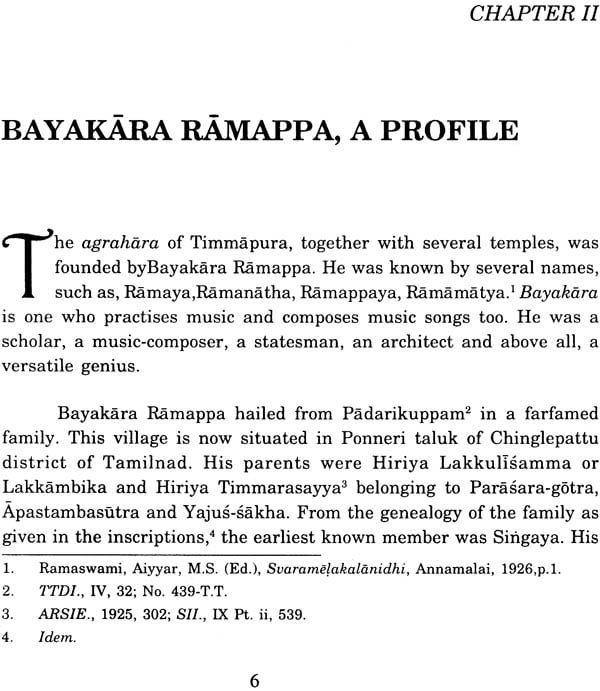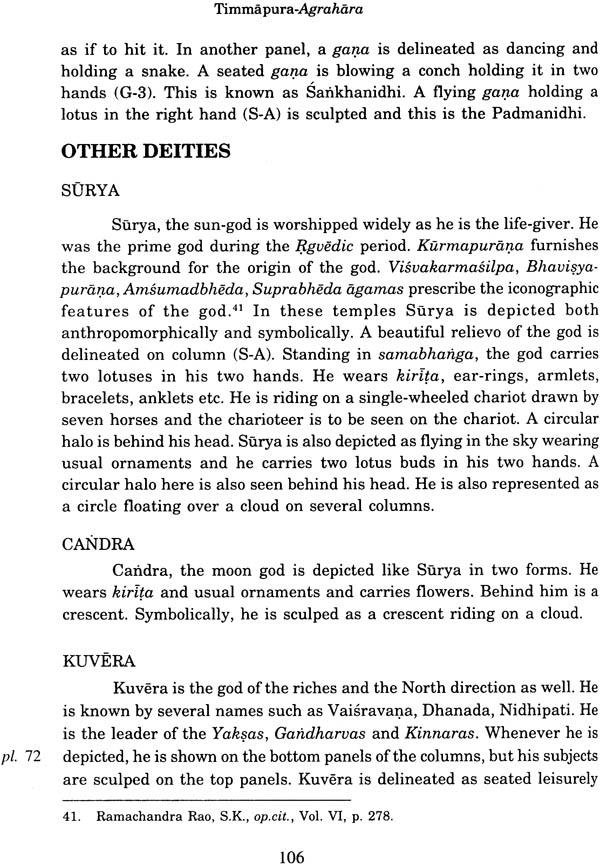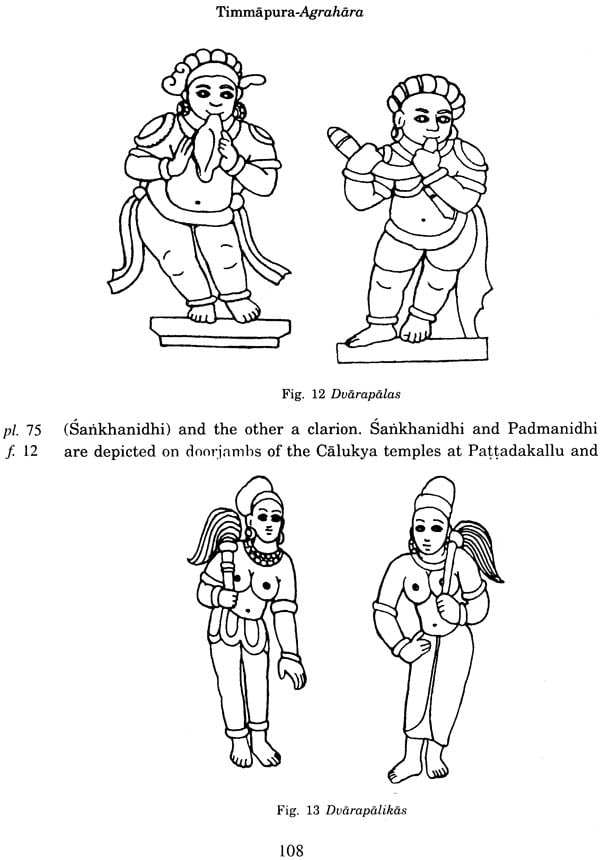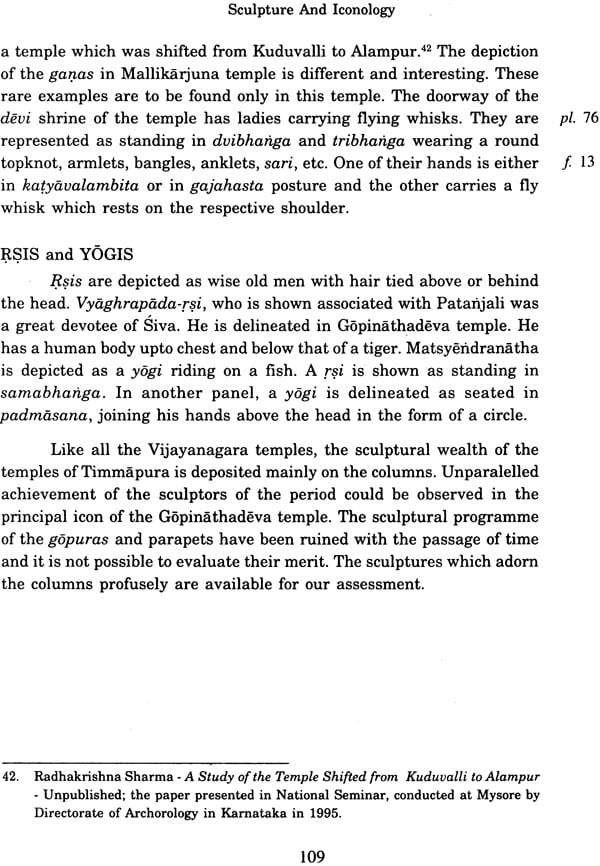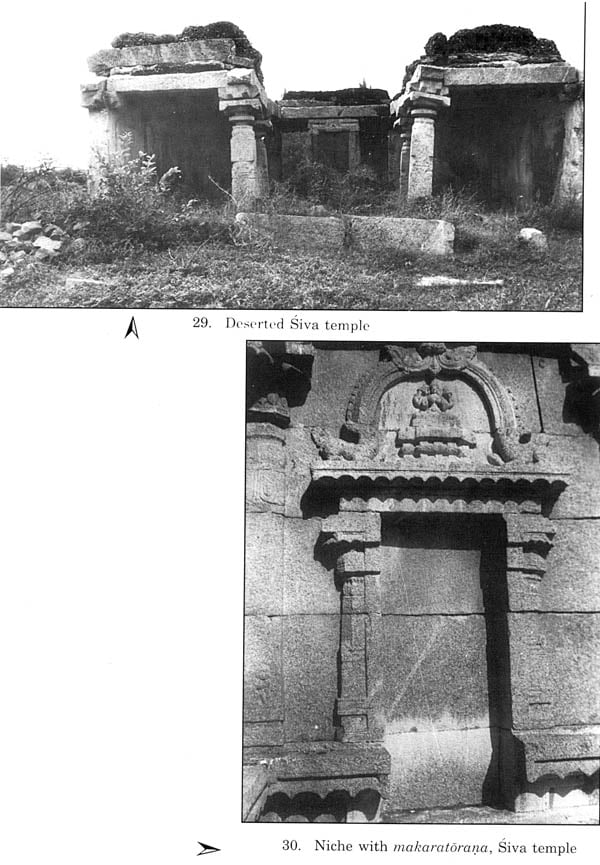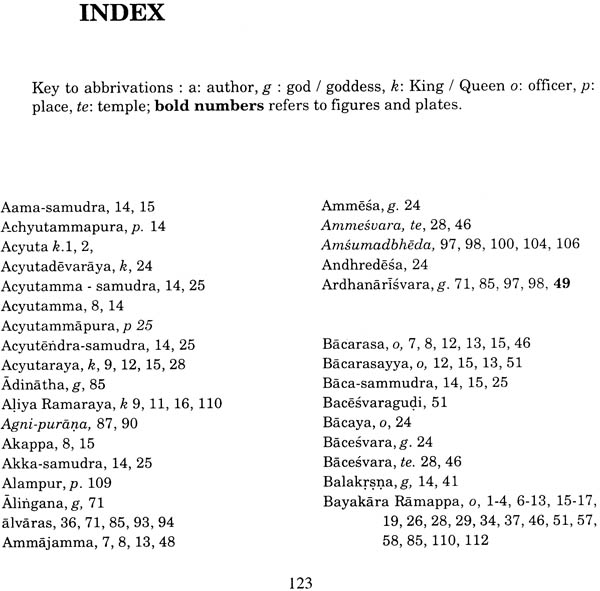
Timmapura Agrahara (A Cultural Study of Vijayanagara- Hampi Temple Complex)
Book Specification
| Item Code: | NAG559 |
| Author: | Dr. S.N. Shivarudraswamy |
| Publisher: | Paurastya Prakashana |
| Language: | English |
| Edition: | 2005 |
| Pages: | 184 (90 B/W Illustrations) |
| Cover: | Hardcover |
| Other Details | 10 inch X 7.5 inch |
| Weight | 540 gm |
Book Description
Timmapura (currently Timmala pura) is a great artistic centre of the Vijayanagara period. This has boon neglected so far. As it is in the close proximity to Hampi, the enormity and grandeur of Ham pi has sidelighted it. But Timmapura has occupied an important place in the long and glorious history of Vijayanagara art. Although it is not a royal foundation. its temples are in no way inferior In some major temples of Hampi like Krsn a and T'iruvengalanathu in their configuration and erection.
Bayakara Ramappa established the Timmapura-Agrahara in the early part of the sixteenth century. He was an astute administrator, profound scholar in Samskrta and music, and renowned architect. He has composed Svaramela kalanidhi in Samskrta. and it is a standard work on Karnatik music. Bavakara Ramappa issued a large number of inscription registering the construction of several temples. as many as sixteen wells and tanks. which are even today serving the people of Bellary district of Karnataka.
Among the several temples he erected at T'immapura , Siva. Gopinatha deva, Mallikarjuna are still in situ. These temples an' noted for artistic and architectural elegance and excellence. Siva temple is rich in rare Saiva sculptural programme. The principal icon of Gopinathadeva temple is a matchless and marvellous creation of the art of this period. A masterly study of this agrahara is the theme of this monograph.
About the Author
Dr. S.N. Shivarudraswamy Professor & Head Dept. of History P.A. College (erstwhile Kalpataru College) Tiptur-572202
Preface
Timmapur a (currently Timmalapura) is a great artistic centre of the Vijayanagara period. This has been neglected so far. As it is in the close proximity to Hampi, the enormity and grandeur of Hampi has sidelighted it. But Timmapura has occupied an important place in the long and glorious history of Vijayanagara art. Although it is not a royal foundation, its temples are in no way inferior to some major temples of Hampi like Krsna and Tiruvengalanatha in their configuration and erection.
Bayakara Ramappa established the Timmapura-Agrahara in the early part of the sixteenth century. He was an astute administrator, profound scholar in Samskrta and music, and renowned architect. He has composed Svaramelakalanidhi in Samskrta, and it is a standard work on Karnatik music. Bayakara Ramappa issued a large number of inscriptions registering the construction of several temples, as many as sixteen wells and tanks, which are even today serving the people of Bellary district of Karnataka.
Among the several temples he erected at Timmapura, Siva, Gopinathadeva, Mallikarjuna are still in situ. These temples are noted for artistic and architectural elegance and excellence. Siva temple is rich in rare Saiva sculptural programme. The principal icon of Gopinathadeva temple is a matchless and marvellous creation of the art of this period. A masterly study of this agrahara is the theme of this monograph.
Many people and institutions have helped me in completing this work. I am indebted to my friend Dr. S. Chandrashekhar, Professor of History, Bangalore University, Bangalore who went through the work and made some valuable suggestions. I am beholden to my friends Sri Balasubrahmanya, Professor of Archaeology, Kannada University, Hampi and, Dr. K.P. Punacha, Director, Archaeological Survey of India, New Delhi, who lent helping hands in many ways. I should like to thank the Director of Epigraphy, Mysore, the Director of the Directorate of Archaeology and Museums in Karnataka, the Superintending Archaeologist of Madras Circle, Channai 'for permitting me to make use of their valuable library. I would also like to record my sincere thanks to the local people and monument attendants of Timmalapura, who assisted me on the spot.
The book has been published with the help of a generous grant of Indian Council of Historical Research, New Delhi. I remember with gratitude the assistance of the Council. This publication grant rendered by the Council reduced the burden of the publisher to a great extent. I am also grateful to Dr. Kaimal, New Delhi and Dr. Arani, Bangalore of the Council, each of whom has helped me in many ways in their official capacities.
Sri S.S. Jagirdar, the Editor of Epigraphia Carnatica Revision and Report Project (Rtd.), Mysore has transcribed the estampage of the inscription No. 6 of this book. Sri Bhauvano Mrtyufijayacaryah, Professor of Samskrta (Rtd.) Kalpataru College, Tiptur has translated the Samskrt portion of the inscriptions of this book into English. I acknowledge their help with gratitude.
I thank Messrs. Paurastya Prakashana, Mysore for accepting this work for publication and to Satyashri Printer Pvt. Ltd., Bangalore for neat and beautiful printing of this book. I offer my deepest appreciation to my wife Smt. Swarna, who prepared several copies of the work on typewriter, whenever I required them.
Introduction
Timmalapura, a small sprawling village in Hospet taluk of Bellary district is situated at a distance of 30 km. from Hospet on the Hospet-Bangalore highway. It is a new settlement established on the becirak (a deserved village) of Timmapura, a medieval town or agrahara. The new village was set up in the 1950s to accommodate the people whose village was submerged in T.E. Dam constructed near Hospet across the Tungabhadra river.
Timmapura-agrahara was founded by Bayakara Ramappa or Ramamatya in the early part of the sixteenth century when Vijayanagara empire had reached the pinnacle of its glory. The Vijayanagara empire came into being in 1336 A.D. and dominated over the entire South India till its fall in the fateful war of Rakkasa-Tangadi in 1565 A.D. Established by Harihara and Bukka of Sangama dynasty, the empire attained its apex during the time of the emperors, Devaraya Ii, Krsnadevaraya, Acyuta and Ramaraya and ushered in a new era in every walks of life. The empire was a fascinating amalgamation of various provinces, communities, sects, languages and personalities, As a result, a coherent atmosphere was created in the empire in protecting, preserving and enriching the traditional culture in all branches of human life like religion, literature, art and architecture.
Hailing from Tamilnadu, Bayakara Ramappa served as an officer m various capacities in several places of Karnataka and also as a provincial governor in Andhra under Acyutaraya and Ramaraya. He was a remarkable administrator, and a profound scholar in Samskrta and music which he inherited from the elders of his family. He transformed the famous village, Cikodu (the present Timmalapura) into an agrahara by the name Sri Timmapura. It was also called Peddatimmapura.' This great task was undertaken by Bayakara Ramappa either to commemorate the name of his father or to provide moral merit for him. He beautified the village by constructing several temples and other buildings. The words of John Ruskin (1819-1900) aptly applies to him in this aspect." He said : 'Great nations write their autobiograpies in three manuscripts, the book of their deeds, the book of their words and the book of their art. Not one of these books can be understood unless we read the two others, but of the three the only trustworthy one is the last'. This is exactly true in case of Bayakara Ramappa and also of the Vijayanagara empire." He has left us enormous works of art in the forms of temples and dams. These temples have immortalised his name and they help us to write his biography and of the Vijayanagara empire.
Ramamatya set up several agraharas in Karnataka and Andhradesa. Agrahara was a village or a large piece of land assigned to. brahmanas for their maintenance. Timmapura-agrahara had occupied a prominent position in the empire as it was in the close proximity of the imperial capital, Vijayanagara. He brought brahmanas from various places to Timmapura. It was teemed with people enchanting Vedas, and it had innumerable temples, wells, groves and dams. He constructed Gopinathadeva, Siva, Mallikarjuna, Virabhadra, Visvanatha and several other temples. The agrahara had three fortified walls which survived till the beginning of this century" and traces of them with their elaborate gateways could be seen even today. Now, Gopinathadeva, Siva and Mallikarjuna temples are comparatively in a good state of preservation. They were surrounded by the inner-most fortified wall which had a gateway just behind Gopinathadeva temple. Traces of the fort wall and the gateways could be seen around these temples. To the left of Mallikarjuna temple, there is a fine well with descending steps on one
Side Once, it had a beautiful arched-doorway whose stone members are lying around the well. Virabhadra and Visvanatha temples together with another beautiful well, known as Lingalayya well, were once surrounded by the second fortified wall. Again this was covered by the third fortified wall encompassing a hillock in the north-west of Gopinathadeva temple. Timmapura had spread over within these fortified walls. A device to make a siren call was kept in the hillock of this place to summon the natives to conduct a meeting or to warn them in the event of a danger and this could be seen on this hillock. Such a place throbbing with widespread life, might have come to an end after the Rakkasa-Tangadi war in 1565 A.D. and the survivors finally abandoned "it. The picturesque sights of Hampi could be seen here also by its hillocks and 'plain lands. When the new village Timmalapura was set up in the area of medieval Timmapura to rehabilitate the people who had lost their houses in the inundation of T.B. Dam at Hospet, the people looted the fortified walls and temples for stone materials. Thus, the ancient monuments of this place disappeared one after the other. The present Timmlapura was the burial area of the medieval Timmapura.
Timmapura-agrahara is noted for Gopinathadeva, Siva and Mallikarjuna temples. Visvanatha and Virabhadra temples are in ruins. Another Siva temple, in a dilapidated condition, is to be seen by the side of Mallikarjuna temple. Traces of some more temples are available within the inner-most fort wall. These temples are one of the finest creations of the Vijayanagra architecture. Keeping in mind that these temples were constructed by an individual of an officer grade, his achievements are really great and his constructions are the best of all the temples of Hampi. During this period, people of all groups and the royal members had fallen in love with the construction of the temples. Profound thoughts of the period were not only expressed in words but also in terms of visual art. A mass movement took place in the erection of temples. Such a wide and powerful movement never took place during the time of any preceding or succeeding dynasties of the Vijayanagara empire in the Indian subcontinent. Ramamatya identified himself in such a country-wide movement and erected these temples, besides a number of barrages and wells. A biographical sketch of him is given in Chapter II. These temples are not as grand and majestic as the dazzling summit of the regal achievements in architecture and sculpture as found in Virupaksa, Vitthala temples at Hampi. Nevertheless, they are not second to them in the point of beauty by their uniqueness and traits of architecture and sculptural programme. Each temple contains its own relevant and novel features for heightening its beauty. This will be discussed in Chapter IV. There are now six inscriptions in Timmapura and some more have been destroyed with the passage of time. They are dealt with in detail with translations under a Chapter, Epigraphy. Two inscriptions of this place are, for the first time, brought into light in this work. These temples are exceedingly rich in sculptural programme. Some rare Saivite figures are, for the first time, depicted in these temples in Karnataka. They are all discussed in extenso in the background of silpa texts in Chapter V.
Timmapura-agrahara was a culturally strategic place. Around this place Bayakara Ramappa created several agrahiiras with temples and large reservoirs which are even today serving the people of Bellary district of Karnataka. Timmapura is the only place in Karnataka which has several Vijayanagara temples in a single place.
Contents
| Preface | ix | |
| List of Illustrations | xi | |
| I | Introduction | 1 |
| II | Bayakara Ramappa - A Profile | 6 |
| As an administrator, As a scholar, As a philanthropist | ||
| III | Epigraphs | 18 |
| IV | Temples | 33 |
| General features, Gopinathadeva temple, Siva temple, Mallikarjuna temple, Deserted temples | ||
| V | Sculpture and Iconology | 67 |
| Sculpture - General features, Iconology-General features, Vaisnava deities, Saivite deities, Other deities | ||
| VI | Conclusion | 110 |
| Glossary | 114 | |
| Bibliography | 119 | |
| Index | 123 |
